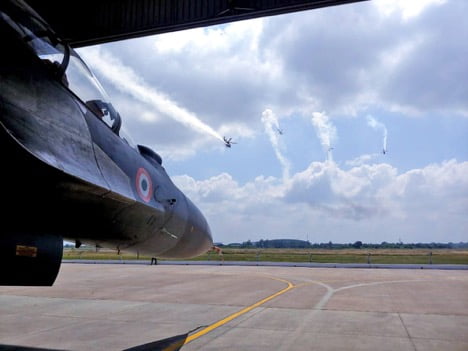By Jimmy Bhatia
New Delhi. Chief of Defence Staff (CDS) General Bipin Rawat and Chief of the Air Staff (CAS), Air Chief Marshal RKS Bhadauria formally inducted the first BrahMos-capable Sukhoi Su-30 MKI squadron in Southern Air Command’s newly developed air base at Thanjavur.
India will now have a new lethal weapons platform to keep a ‘strategic eye’ over the Indian Ocean Region (IOR) with capability to carry out both air superiority and maritime roles on both flanks of India’s southern peninsula, as well as in the southern maritime areas.
The hitherto number-plated No. 222 Squadron also known as the ‘Tigersharks’ has been resurrected and given the honour to be the first squadron to be equipped with the 2.5-tonne air-launched version of the lethal tri-sonic BrahMos missile. Primarily tasked with a maritime strike role, these Sukhois will be a “huge addition to IAF’s operational capabilities”, Air Chief Marashal Bhadauria said.
Tigersharks is the 12th squadron of the 4th-generation ‘air dominance’ Sukhois but the first one to be based in south India after the first 11 were deployed on the western and eastern fronts, from Pune and Jodhpur in South-Western Air Command; Halwara and Sirsa in Western Air Command; Bareilly in Central Air Command and; Tezpur and Chabua in Eastern Air Command, to cater for Pakistan and China. With the newly formed Su-30 MKI squadron in Thanjavur, IAF can boast of having same type combat squadrons in all its operational commands. Of course, Southern Air Command also has the lone LCA Tejas No. 45 Squadron based at Sulur.
‘Tigersharks’ is initially being commissioned with just four to six fighters at Thanjavur. More BrahMos-modified aircraft will keep getting added till the Squadron gets its full complement of 18 fighters by the end of the year. With a combat radius of almost 1,500 km without midair refuelling, the Sukhoi will combine with the 290-km range BrahMos missile to constitute a formidable weapons package. With mid-air refuelling, the jet would be able to easily cover not only the waters of Bay of Bengal and Southern Arabian Sea but also have an extended reach in the Indian Ocean to the south.
“The Indian Ocean Region (IOR), which is a central maritime spread bordering three continents, has an important role to play in regional peace, security and prosperity. The IAF is an intrinsically strategic force and is all extend its reach into the vast IOR”, Air Marshal Amit Tiwari, AOC-in-C Southern Air Command had said just prior to the Squadron’s induction into Thanjavur.
The deployment at Thanjavur is clearly in response to China’s fast-expanding strategic footprint in the IOR, building a ‘String of Pearls’ around India with maritime bases/logistics facilities in countries starting from Myanmar, Sri Lanka (Hambantota), Pakistan (Karachi and Gwadar) and Djibouti in the Horn of Africa.
No. 222 Squadron incidentally, was first raised at the IAF’s Ambala base in Haryana in 1969, with the good-old Sukhoi Su-7 swept-wing fighter jets. It took part in the 1971 Indo-Pak War from Air Force Station Halwara where it was moved in July 1971, earning a sizable number of gallantry awards, viz. one Mahavir Chakra, three Vir Chakras and three Vayu Sena Medals. In 1985, the ‘Tigersharks’ were the first squadron to be equipped with MiG-27 aircraft. The Squadron was decommissioned in 2011.
BrahMos director-general Sudhir Mishra said in a statement, “It’s the realisation of our dream to provide IAF with a formidable and much-desired capability to strike from long stand-off distances on any target at sea or on land with pinpoint accuracy.”
Incidentally, DRDO is also developing ultra-light variants of the air-launched version of BrahMos missile. Once developed, even the LCA will be able to carry two of these on under-wing pylons. Su-30 MKI, in this case, would be able to carry as many as three BrahMOs missiles – two under-wings, along with the already mated 2.5-tonne belly missile, a formidable anti-shipping combat punch indeed.
Notably, the Navy already operates its Poseidon-8I long-range maritime patrol aircraft, which are packed with sensors and weapons to detect, track and destroy enemy submarines, from its INS Rajali base at Arakkonam in Tamil Nadu. Armed with BrahMos missiles, the Sukhois will further add to this deterrence over the high seas right up to the Malacca Strait.
This article was published by our partner India Strategic in January 2020.


